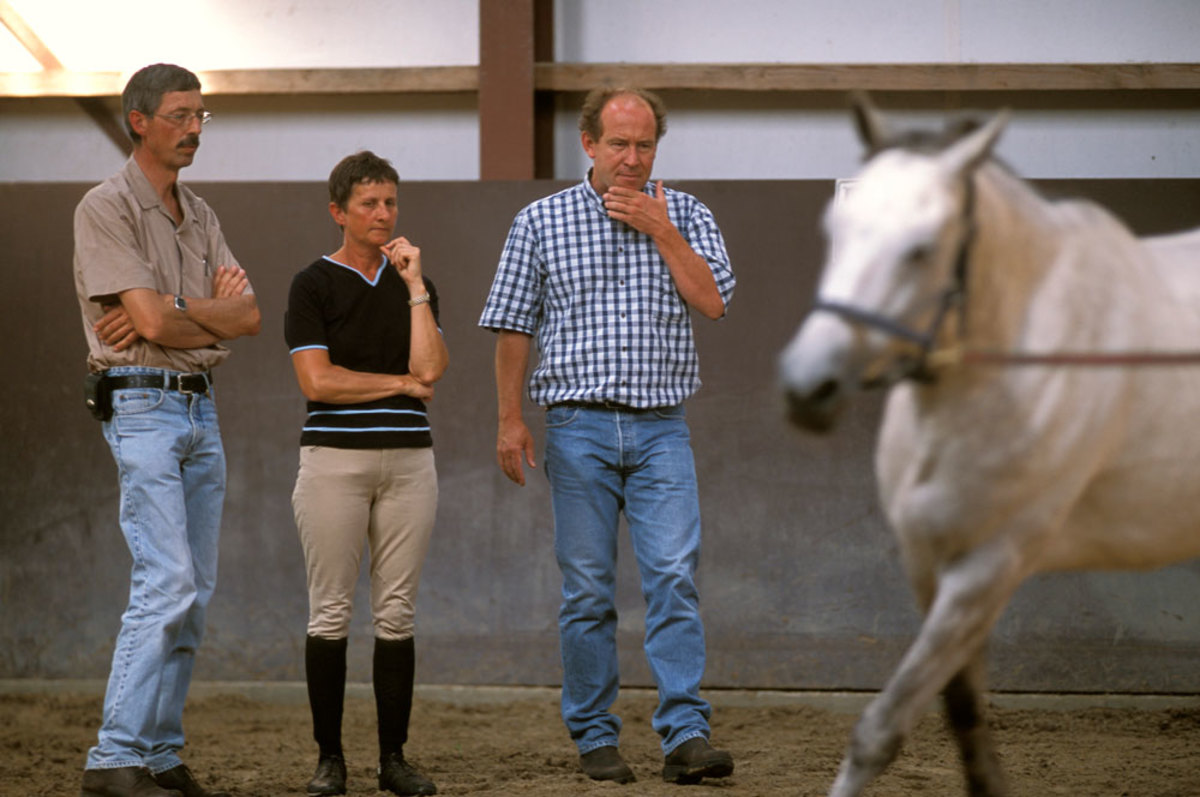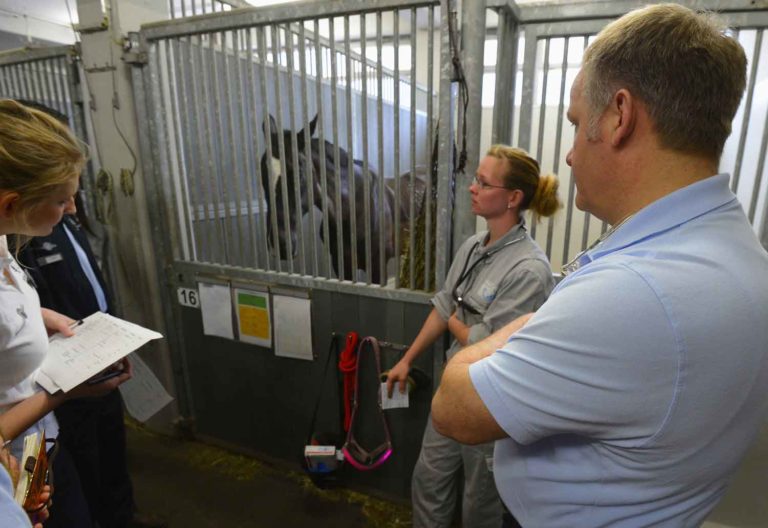
There can be much to enjoy about doing a pre-purchase exam, including getting to do a truly in-depth exam with the horse and partnering with the client at the start of an exciting new owner-horse relationship. However, there is often just as much, if not more, that is aggravating and frustrating.
In many cases, this is due to the number of individuals involved and the burden that places on the veterinarian’s time and resources. At a minimum, there is a seller, a buyer and a veterinarian.
Even at the best of times, having the seller involved amplifies the intrinsic challenges in communication and coordination that exist in the veterinarian- client relationship.
However, as we well know, there are usually more players—and opinions—than just the three mentioned above. There are often agents, riders, grooms, barn managers, trainers and so on.
Managing the complex dynamics that exist when there are so many individuals involved can be demanding and challenging. It necessitates intentionality and benefits from having an established system that supports efficiency and good medicine. It’s also important to acknowledge that, in addition to the sheer number of people that can be involved, tensions are often running high and there are pressures on many of the parties to make the sale.
In this setting of opinions and stress, it can be difficult to find one’s way to engage with the seller in an authentic way to meet his or her needs and expectations with a pre-purchase exam.
Despite the difficulty, often there is value in working toward understanding the complex interpersonal dynamics. Understanding the influences on the buyer, particularly if he or she is your long-term client, can support your ability to council that person effectively and make an informed decision.
Here are some constructive ideas to facilitate the pre-purchase exam process.
Connect to a Purpose
As a guiding principle, it helps to stay connected to the purpose of the pre-purchase exam. That purpose is to provide an accurate picture of the horse’s health at the time of the exam and share that with the client so he or she can make an informed decision about the horse’s suitability.
There are many variables that exist in the circumstances of pre-purchase examinations, and many personalities. If we remember what the exam is for and its limitations, then we can more easily navigate the process.
Logistics
Pragmatically, there is tremendous benefit to bringing a trusted and competent assistant with you to the call. This will give those present at the exam—whether seller, buyer or others—the ability to be fully engaged in watching the exam and communicating with you.
Further, as you proceed through the exam, that person can take notes or fill in paperwork to ensure everything is recorded accurately. This adds efficiency to the process by having your medical record and pre-purchase report started.
Get It in Writing
Paperwork can feel burdensome, but in the case of pre-purchase exams, it is a crucial piece of quality assurance and liability protection. This includes having a health history form that is completed by the seller and a report of your findings to be provided to the buyer. Having templates for these at your fingertips and only scheduling the exam once the history form has been returned can save a lot of headaches.
Another idea is to include a questionnaire for the buyer prior to the examination where he or she indicates, in writing, the desired components of the examination (e.g., radiography, drug screen, endoscopy). The questionnaire can be made more useful if it’s annotated describing the purpose and cost of each component. Of course, things can change during the course of the examination, but it provides a starting point and can expedite the process.
Be Curious!
This is simple, but not easy, advice to follow, particularly in the context of pre-purchase exams. When the purchase is for an established client, for the most part, that established relationship is an asset because one knows more about the person’s situation, capabilities and what he or she is looking for from the examination.
The client is also more likely to understand how you, as a veterinarian, approach things. The fact that the person has chosen you to do the pre-purchase exam demonstrates a confidence and comfort with you.
However, when doing a purchase exam for an unknown buyer, particularly if the buyer is not on site, the uncertainties start to add up and the importance of being curious is amplified. To this end, being curious and asking questions of the buyer and that person’s entourage can provide valuable information that eases the process. Using open-ended questions is the most efficient way to gather this type of information!
Investigate Expectations, Then Shape Them
Expectations are ubiquitous in our lives. We have expectations of ourselves and others. Despite this, most of expectations are held subconsciously, and we only notice them when they are not met and we’re faced with the consequences of frustration, disappointment or anger. These feelings can result when we don’t meet our own expectations or another person has not met the expectations we have for him or her.
In the context of a pre-purchase exam, managing our expectations as veterinarians and helping our clients manage theirs markedly increases the chance of a positive outcome for all parties.
A critical expectation to discuss is what can and cannot be determined in a purchase exam. We need to remind clients that we do not have crystal balls and cannot predict the future. This is a lighthearted and relatable way of imparting that purchase exams do not come with guarantees about the horse’s future.
What can be provided is the horse’s current health status—a snapshot in time—as well as a discussion about how the findings might or might not influence the horse’s career.
It’s important to do more than educate the client about what you deem to be appropriate expectations. It’s critical to explore the expectations of that person. This can be done simply by asking what they are. This would sound like “What are your expectations of me in this process?” or “What information are you expecting at the end of this exam?” or “What experiences have you had with purchases in the past?”
This will give you valuable information that supports your ability to interface with the client effectively and to work toward a successful outcome for everyone.
Communicate for Clarity
When emotions and stress levels are running high, it is difficult for clients to remember the content of conversations clearly. As veterinarians, the responsibility falls to us to ensure we’re delivering our message in a way the client can receive it.
The best ways to do this are through the use of empathy statements and pausing. This means tuning into the client’s emotional state, then ensuring that it is overtly acknowledged. This might sound like “I hear that you’re worried about seeing that chip on the hock; it’s not what we were expecting.” Follow this statement with at least a five-second pause before continuing on with a discussion about whether he or she would like to proceed with additional radiographs. This will give the client a chance to manage disappointment and allow him or her to make a better decision.
Another useful communication tool that supports clarity of information exchange is to have the client repeat back to you the information shared with you in his or her own words. This can seem like a tricky thing to accomplish without it sounding condescending or like you are quizzing the client. However, often it can be done by framing it as wanting to ensure that the client has fully understood the message you are conveying.
This could sound like “I know you’re probably going to have to share this information with other people; do you want to run past me what you’d tell them. That way we can make sure I’ve done a good job explaining it to you.”
When done well, this communication skill leaves the veterinarian confident that information has successfully been imparted and understood. The client is empowered with this newfound, and correct, knowledge.
References and Resources
A tricky part of a pre-purchase exam is trying to make accurate predictions based on the findings of the examination. As veterinarians, we have a not-so-secret weapon: peer-reviewed literature.
Whether we are trying to educate an owner about the radiographic findings and their potential impact on the horse’s athletic future or speaking with another veterinarian, knowing what research has been done on that particular condition can alleviate some of the subjectivity of the findings and provide all parties with more confidence in their decisions.
Establish Good Boundaries
Lastly, the phrase “not my monkeys, not my circus” comes to mind. While there is value in understanding the interpersonal factors at play surrounding the potential purchase of the horse, it is important to remember that the decision to purchase the horse does not belong to the veterinarian.
Keeping this in the front of your mind can reduce some of the stress associated with the process. It also can keep your focus on what can be controlled, namely conducting a thorough and high-quality pre-purchase exam, as well as communicating the findings to the buyer in language that he or she can understand.

![[Aggregator] Downloaded image for imported item #18782](https://s3.amazonaws.com/wp-s3-equimanagement.com/wp-content/uploads/2025/11/03125751/EDCC-Unbranded-13-scaled-1-768x512.jpeg)
![[Aggregator] Downloaded image for imported item #18375](https://s3.amazonaws.com/wp-s3-equimanagement.com/wp-content/uploads/2025/09/30140031/EDCC-Unbranded-26-scaled-1-768x512.jpeg)

